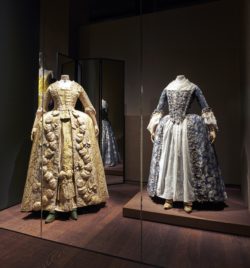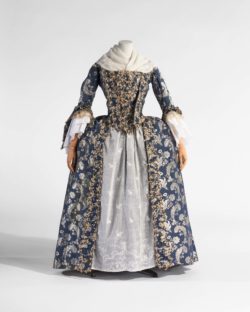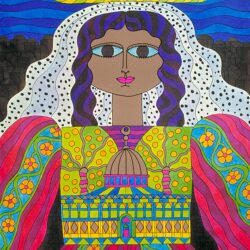The Conservation of a Pair of 18th-Century Shoes

Objects are conservated on a regular basis in MoMu's conservation studio. Every year, an average of about 30 objects are treated in the in-house studio. Occasionally, there is a collaboration with an external conservator-restorer or with the Heritage Studies programme at the University of Antwerp. Most objects in MoMu are treated in function of the exhibitions. Most recently, Textile Conservator Kim Verkens undertook the challenge of treating a pair of 18th-century shoes, which is currently on view in the 'Collection presentation - Fashion from the MoMu Collection'.

The pair of embroidered silk shoes is presented with a Robe à l'Anglaise. Like the Robe à la Française, this was a very typical style for this period. Adding them to this 18th-century silhouette gives an idea of how women were dressed at the time. The pair is one of the few examples of shoes from the eighteenth century in the MoMu Collection. They come from the donation of Jacoba de Jonge, which was included in the MoMu Collection in 2012.

The heeled shoes are made in chamois leather and embroidered with flowers in coloured silk. The condition of these shoes is reasonably well. Only the silk finishing ribbon is completely gone. As a result, the edges of the shoes were standing open at the top and are completely out of shape. Originally, this type of shoe was finished with a silk ribbon. This part of the shoe has often partially or completely disappeared when it comes to shoes of from this period. After all, silk is very fragile and not always resistant to the ravages of time.

In this case, only a few fragments of the silk ribbon were still present on the shoes. Based on these remnants, the original colour and size were determined. The old sewing marks on the shoe made it very clear how the ribbon was originally attached. It was therefore decided to carry out a restoration treatment and reattach the ribbon. Here, reversibility was taken into account: every intervention has to be reversible. A silk ribbon of the same size was dyed in a similar colour and sewn on with fine silk thread. The ribbon not only made an optical difference, but also allows the tops of the shoe to be closed again. This gives more strength and keeps them in better shape.

What is the difference between conservation and restoration?
In the case of conservation - in most cases - the original condition is approximated as closely as possible and the damage is consolidated. We speak of restoration when an addition is made to match the original condition as much as possible.

The 'Collection presentation - Fashion from the MoMu Collection' sheds light on avant-garde Belgian and international fashion, with an alternating presentation of silhouettes and archive material from the museum's permanent collection of more than 38,000 items. More info


